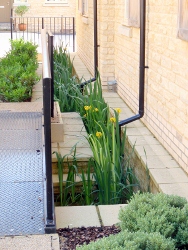- Delivering SuDS
- Using SuDS
- Background
- SuDS principles
- Benefits of SuDS
- Benefits of SuDS
- Why developers should choose SuDS
- Flood risk management
- Water quality management
- Biodiversity & ecology
- Amenity
- Air quality
- Building temperature
- Carbon reduction and sequestration
- Crime
- Economic growth
- Enabling development
- Flexible infrastructure/climate change adaptation
- Education
- Groundwater recharge
- Health and well being
- Pumping wastewater
- Rainwater harvesting
- Recreation
- Tourism
- Traffic calming
- Treating wastewater
- SuDS components
- SuDS components overview
- Source control
- Swales & conveyance channels
- Filtration
- Infiltration
- Retention & detention
- Wetlands
- Inlets, outlets and control structures
- SuDS performance & monitoring
- Delivery
- The costs & benefits of SuDS
- Adoption & maintenance of SuDS
- Legislation & regulation
- Design guidance
- Retrofitting SuDS
- Drainage exceedance
Component: Channels & rills
Description
Canals and rills are open surface water channels with hard edges. They are simply channels that water flows along whereby they can have a variety of cross sections to suit the urban landscape, including the use of planting to provide both enhanced visual appeal and water treatment.
Treatment channels collect water, slow it down and provide storage for silt and oil that is captured. The outlets are designed to act as a mini oil separator; hence the channels can be very effective at treating pollution.
Advantages & disadvantages
|
Advantages |
Disadvantages |
|
|
Where component can be used
Residential: Yes
Commercial/industrial: Yes
High density: Yes
Retrofit: Yes
Contaminated sites: Yes (with liner)
Sites above vulnerable groundwater: Yes (with liner)
Performance
Peak flow reduction: Medium
Volume reduction: Medium
Water quality treatment: Medium – high (design dependent)
Amenity potential: Medium – high (design dependent)
Ecology potential: Design dependent
Maintenance
-
Routine maintenance
-
Removing litter/debris
-
Intensive maintenance required once every 5 years (i.e. to remove silt etc.)
Read more on:





